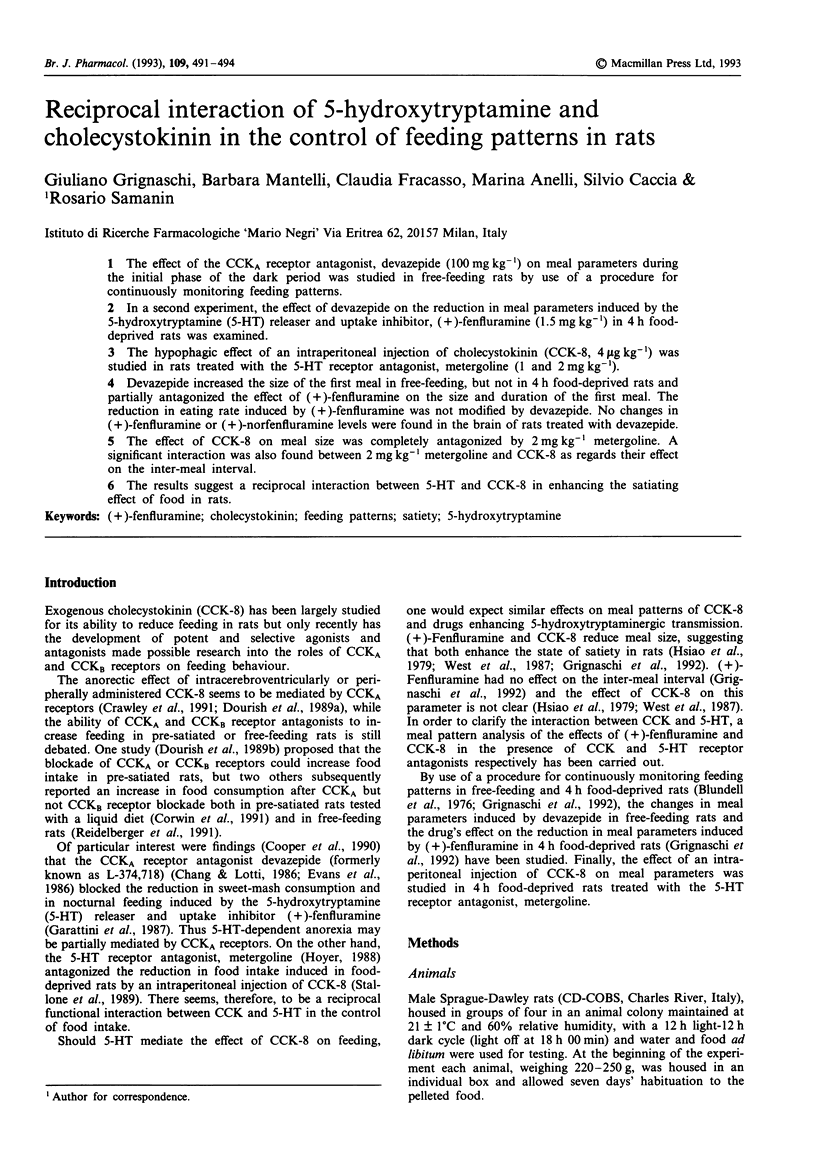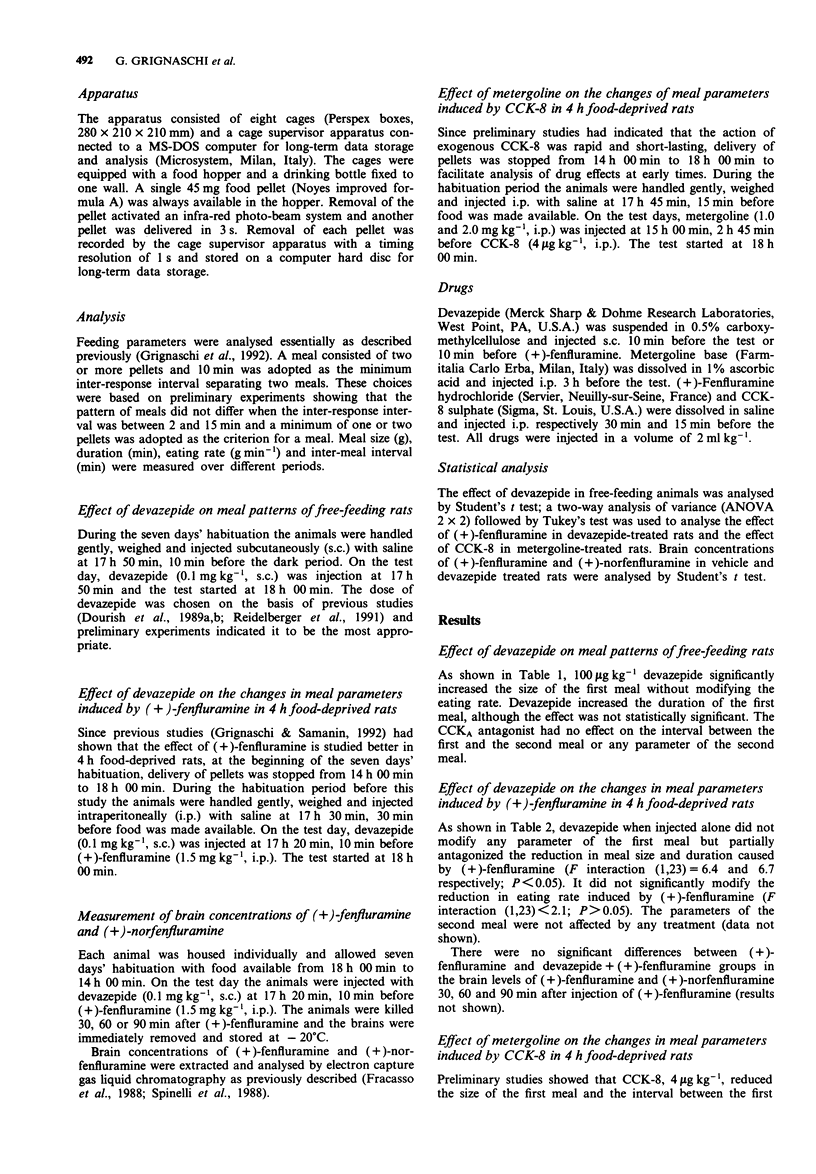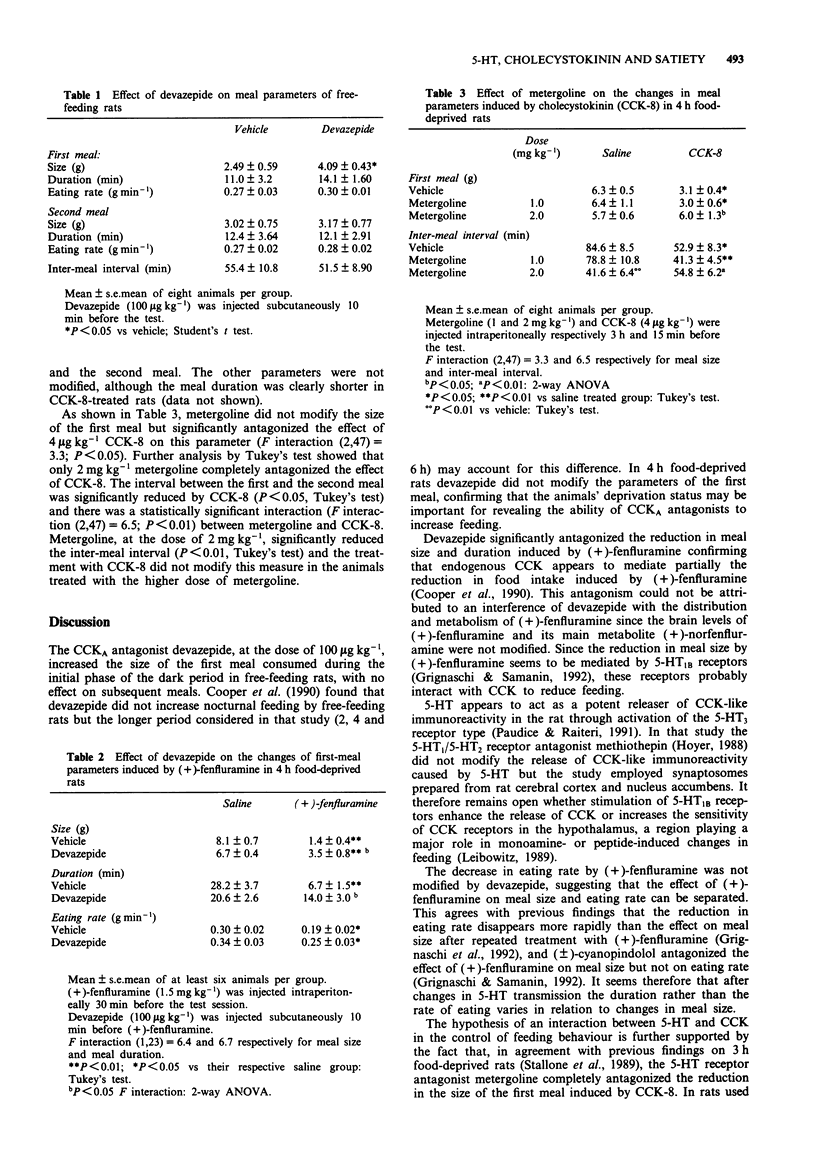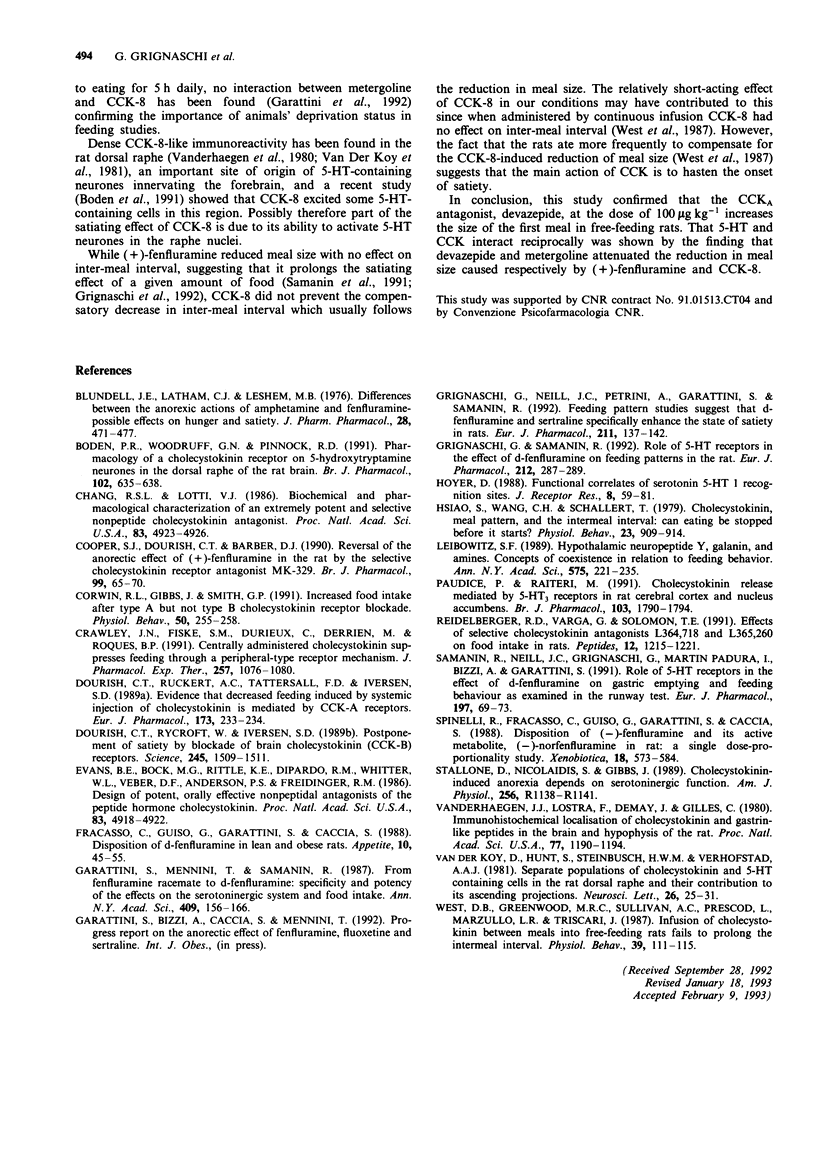Abstract
1. The effect of the CCKA receptor antagonist, devazepide (100 mg kg-1) on meal parameters during the initial phase of the dark period was studied in free-feeding rats by use of a procedure for continuously monitoring feeding patterns. 2. In a second experiment, the effect of devazepide on the reduction in meal parameters induced by the 5-hydroxytryptamine (5-HT) releaser and uptake inhibitor, (+)-fenfluramine (1.5 mg kg-1) in 4 h food-deprived rats was examined. 3. The hypophagic effect of an intraperitoneal injection of cholecystokinin (CCK-8, 4 micrograms kg-1) was studied in rats treated with the 5-HT receptor antagonist, metergoline (1 and 2 mg kg-1). 4. Devazepide increased the size of the first meal in free-feeding, but not in 4 h food-deprived rats and partially antagonized the effect of (+)-fenfluramine on the size and duration of the first meal. The reduction in eating rate induced by (+)-fenfluramine was not modified by devazepide. No changes in (+)-fenfluramine or (+)-norfenfluramine levels were found in the brain of rats treated with devazepide. 5. The effect of CCK-8 on meal size was completely antagonized by 2 mg kg-1 metergoline. A significant interaction was also found between 2 mg kg-1 metergoline and CCK-8 as regards their effect on the inter-meal interval. 6. The results suggest a reciprocal interaction between 5-HT and CCK-8 in enhancing the satiating effect of food in rats.
Full text
PDF



Selected References
These references are in PubMed. This may not be the complete list of references from this article.
- Blundell J. E., Latham C. J., Leshem M. B. Differences between the anorexic actions of amphetamine and fenfluramine--possible effects on hunger and satiety. J Pharm Pharmacol. 1976 Jun;28(6):471–477. doi: 10.1111/j.2042-7158.1976.tb02768.x. [DOI] [PubMed] [Google Scholar]
- Boden P. R., Woodruff G. N., Pinnock R. D. Pharmacology of a cholecystokinin receptor on 5-hydroxytryptamine neurones in the dorsal raphe of the rat brain. Br J Pharmacol. 1991 Mar;102(3):635–638. doi: 10.1111/j.1476-5381.1991.tb12225.x. [DOI] [PMC free article] [PubMed] [Google Scholar]
- Chang R. S., Lotti V. J. Biochemical and pharmacological characterization of an extremely potent and selective nonpeptide cholecystokinin antagonist. Proc Natl Acad Sci U S A. 1986 Jul;83(13):4923–4926. doi: 10.1073/pnas.83.13.4923. [DOI] [PMC free article] [PubMed] [Google Scholar]
- Cooper S. J., Dourish C. T., Barber D. J. Reversal of the anorectic effect of (+)-fenfluramine in the rat by the selective cholecystokinin receptor antagonist MK-329. Br J Pharmacol. 1990 Jan;99(1):65–70. doi: 10.1111/j.1476-5381.1990.tb14655.x. [DOI] [PMC free article] [PubMed] [Google Scholar]
- Corwin R. L., Gibbs J., Smith G. P. Increased food intake after type A but not type B cholecystokinin receptor blockade. Physiol Behav. 1991 Jul;50(1):255–258. doi: 10.1016/0031-9384(91)90529-w. [DOI] [PubMed] [Google Scholar]
- Crawley J. N., Fiske S. M., Durieux C., Derrien M., Roques B. P. Centrally administered cholecystokinin suppresses feeding through a peripheral-type receptor mechanism. J Pharmacol Exp Ther. 1991 Jun;257(3):1076–1080. [PubMed] [Google Scholar]
- Dourish C. T., Ruckert A. C., Tattersall F. D., Iversen S. D. Evidence that decreased feeding induced by systemic injection of cholecystokinin is mediated by CCK-A receptors. Eur J Pharmacol. 1989 Dec 7;173(2-3):233–234. doi: 10.1016/0014-2999(89)90528-1. [DOI] [PubMed] [Google Scholar]
- Dourish C. T., Rycroft W., Iversen S. D. Postponement of satiety by blockade of brain cholecystokinin (CCK-B) receptors. Science. 1989 Sep 29;245(4925):1509–1511. doi: 10.1126/science.2781294. [DOI] [PubMed] [Google Scholar]
- Evans B. E., Bock M. G., Rittle K. E., DiPardo R. M., Whitter W. L., Veber D. F., Anderson P. S., Freidinger R. M. Design of potent, orally effective, nonpeptidal antagonists of the peptide hormone cholecystokinin. Proc Natl Acad Sci U S A. 1986 Jul;83(13):4918–4922. doi: 10.1073/pnas.83.13.4918. [DOI] [PMC free article] [PubMed] [Google Scholar]
- Fracasso C., Guiso G., Garattini S., Caccia S. Disposition of D-fenfluramine in lean and obese rats. Appetite. 1988 Feb;10(1):45–55. doi: 10.1016/s0195-6663(88)80032-1. [DOI] [PubMed] [Google Scholar]
- Garattini S., Mennini T., Samanin R. From fenfluramine racemate to d-fenfluramine. Specificity and potency of the effects on the serotoninergic system and food intake. Ann N Y Acad Sci. 1987;499:156–166. doi: 10.1111/j.1749-6632.1987.tb36207.x. [DOI] [PubMed] [Google Scholar]
- Grignaschi G., Neill J. C., Petrini A., Garattini S., Samanin R. Feeding pattern studies suggest that d-fenfluramine and sertraline specifically enhance the state of satiety in rats. Eur J Pharmacol. 1992 Feb 11;211(2):137–142. doi: 10.1016/0014-2999(92)90520-e. [DOI] [PubMed] [Google Scholar]
- Grignaschi G., Samanin R. Role of 5-HT receptors in the effect of d-fenfluramine on feeding patterns in the rat. Eur J Pharmacol. 1992 Mar 3;212(2-3):287–289. doi: 10.1016/0014-2999(92)90346-6. [DOI] [PubMed] [Google Scholar]
- Hoyer D. Functional correlates of serotonin 5-HT1 recognition sites. J Recept Res. 1988;8(1-4):59–81. doi: 10.3109/10799898809048978. [DOI] [PubMed] [Google Scholar]
- Hsiao S., Wang C. H., Schallert T. Cholecystokinin, meal pattern, and the intermeal interval: can eating be stopped before it starts? Physiol Behav. 1979 Nov;23(5):909–914. doi: 10.1016/0031-9384(79)90199-9. [DOI] [PubMed] [Google Scholar]
- Leibowitz S. F. Hypothalamic neuropeptide Y, galanin, and amines. Concepts of coexistence in relation to feeding behavior. Ann N Y Acad Sci. 1989;575:221–235. doi: 10.1111/j.1749-6632.1989.tb53245.x. [DOI] [PubMed] [Google Scholar]
- Paudice P., Raiteri M. Cholecystokinin release mediated by 5-HT3 receptors in rat cerebral cortex and nucleus accumbens. Br J Pharmacol. 1991 Jul;103(3):1790–1794. doi: 10.1111/j.1476-5381.1991.tb09864.x. [DOI] [PMC free article] [PubMed] [Google Scholar]
- Reidelberger R. D., Varga G., Solomon T. E. Effects of selective cholecystokinin antagonists L364,718 and L365,260 on food intake in rats. Peptides. 1991 Nov-Dec;12(6):1215–1221. doi: 10.1016/0196-9781(91)90197-w. [DOI] [PubMed] [Google Scholar]
- Samanin R., Neill J. C., Grignaschi G., Padura I. M., Bizzi A., Garattini S. Role of 5-HT receptors in the effect of d-fenfluramine on gastric emptying and feeding behaviour as examined in the runway test. Eur J Pharmacol. 1991 May 2;197(1):69–73. doi: 10.1016/0014-2999(91)90366-x. [DOI] [PubMed] [Google Scholar]
- Spinelli R., Fracasso C., Guiso G., Garattini S., Caccia S. Disposition of (-)-fenfluramine and its active metabolite, (-)-norfenfluramine in rat: a single dose-proportionality study. Xenobiotica. 1988 May;18(5):573–584. doi: 10.3109/00498258809041694. [DOI] [PubMed] [Google Scholar]
- Stallone D., Nicolaïdis S., Gibbs J. Cholecystokinin-induced anorexia depends on serotoninergic function. Am J Physiol. 1989 May;256(5 Pt 2):R1138–R1141. doi: 10.1152/ajpregu.1989.256.5.R1138. [DOI] [PubMed] [Google Scholar]
- Vanderhaeghen J. J., Lotstra F., De Mey J., Gilles C. Immunohistochemical localization of cholecystokinin- and gastrin-like peptides in the brain and hypophysis of the rat. Proc Natl Acad Sci U S A. 1980 Feb;77(2):1190–1194. doi: 10.1073/pnas.77.2.1190. [DOI] [PMC free article] [PubMed] [Google Scholar]
- West D. B., Greenwood M. R., Sullivan A. C., Prescod L., Marzullo L. R., Triscari J. Infusion of cholecystokinin between meals into free-feeding rats fails to prolong the intermeal interval. Physiol Behav. 1987;39(1):111–115. doi: 10.1016/0031-9384(87)90407-0. [DOI] [PubMed] [Google Scholar]
- van der Kooy D., Hunt S. P., Steinbusch H. W., Verhofstad A. A. Separate populations of cholecystokinin and 5-hydroxytryptamine-containing neuronal cells in the rat dorsal raphe, and their contribution to the ascending raphe projections. Neurosci Lett. 1981 Oct;26(1):25–30. doi: 10.1016/0304-3940(81)90420-1. [DOI] [PubMed] [Google Scholar]


